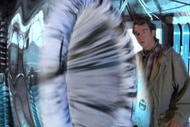Create a free profile to get unlimited access to exclusive videos, sweepstakes, and more!
The creator of 'Kaleidoscope' reveals the order he wrote the series
Which order did you watch Kaleidoscope? Was it the same as the order in which creator Eric Garcia wrote them?

On New Year's Day, Netflix released a new heist thriller, Kaleidoscope, which was constructed to give the viewer an unique viewing experience based on which episodes they choose to watch, and in what order they watched them. Each episode is named for a color — "Yellow," "Green," "Blue," "Orange," "Violet," "Pink," and "Red" — and once those have been viewed, the final episode, "White," is unlocked. And while the story at the heart of the series, which stars Giancarlo Esposito as the heist leader, is based on an actual brazen $70 billion theft of bonds during Hurricane Katrina, the series created by Eric Garcia is both a homage to the genre and a quasi-Rorschach test experiment of how audiences can change their own experience with a series based on how they ingest the story.
As a concept, Garcia tells SYFY WIRE that he first through about the idea in 2014 after he found out about the actual heist that barely got covered in mainstream media. "I was always fascinated by the missing bonds that disappeared right after Katrina. There are so few articles [about it], which is, of course, what I found so fascinating. The other side of it was very much the structural side. It was an idea that I can track it back to an email I wrote to a friend of mine. The earliest thing I found about it on my computer, which was 2014. I said to a friend, who is a director, 'I think there's no reason we should have to watch things in order these days.'"
Garcia subsequently laid out a basic pitch that wasn't even heist-based, but posed an interactive story that would change based on the lens of how the viewer received background information on the characters that might impact their biases or sympathy as they watch. "I said, 'I don't know what the story is yet. I don't even know exactly how to do this yet. But I think that is possible.' And from there, it grew," he says. "And then the two things coalesced."
The show was, fittingly, originally called Jigsaw, but that title was eventually scrubbed due to the character in the Saw horror franchise. Luckily the title Kaleidoscope ended up fitting perfectly with Garcia's inclination to name the episodes for colors. Once Netflix picked up the series, Garcia says he set up his writers' room inside a huge office building that could house a small army of whiteboards needed to craft the episodes in parity.
"I made them buy so many whiteboards and we specifically had them on wheels," Garcia recalls with a laugh. "Every episode had a couple of whiteboards, but really the main one was when we were breaking that [specific] episode. But we also have the ones that were the ones in between, that would detail those specific connections, right? Because the whole idea is that if we're going to do this, and we're going to make this web, you have to be able to introduce characters to the audience in ways that are fresh and new and non repetitive. That's the challenge, and you have to throw out a lot of the writing tricks that you learn throughout a career. A lot of it was treating each episode as if it were a pilot, but then making sure that we did not go stale."
Garcia says they figured out that every episode had to give audiences something new about each character. "We might be introduced to the characters in the 'Blue' episode in one way, but then we would see them differently in the the 'Yellow' episode. And hopefully, what you do as you watch all of them is you get a different viewpoint, you get a different lens. And by the time you're done, you have sort of a holistic version of them; a gestalt view on each of these characters. But hopefully, my theory is, depending on the order you've seen them, your view will be slightly different from mine, because as you come to know somebody, it changes."
"Like it's no spoiler that Roger (Rufus Sewell) is the mark," Garcia continues. "Those are often the ones who you look at and you go, 'Oh, that's the bad guy,' even though yes, the rest of them are thieves. As humans, we have an affinity towards heisters, and I certainly do. And as viewers, I think we naturally take this antagonistic attitude toward that kind of character. But it was important to me that we see him in a way where you could watch an episode — and I think particularly 'Violet,' 'Blue,' and 'Yellow' — where you can look at Roger, and if you come in at the right part, think 'Okay, I get this guy. I'm on this guy's side.' And then you watch another one and go, 'Wait. I'm not necessarily on his side.' I'd love to be able to do that with all the characters and that was sort of a goal."
Garcia says starting with "Pink," even though its the last chronological episode, might sway a lot of audience opinion about the clear antagonist of the piece, safecracker Bob (Jai Courtney). "I think it's fascinating," he says. "And I think all ways of watching are valid. Everyone keeps asking my favorite, but they are all like my children. I have no favorite. But 'Pink' is one of those episodes where I think if you watch it first, you will have a really different viewpoint on Bob and Judy (Rosaline Elbay) and the relationship that he has to the entire thing. Whereas, if you're watching Bob starting from 'Yellow' or 'Blue,' I think your brain goes to a different place. Of all the little experiments that I'm curious to see how these shake out, that's certainly one of them."
For those curious, Garcia confirms that the run order on Netflix is the general order in which they wrote the episodes. "I wrote the 'Yellow' episode first and I wrote the 'Red' episode second. Then we got the stories up and running all around them, and then it bounced back and forth. And as one [episode] would change, registering the natural course of production, whether it's notes, actors, or we lose location, it would change other stuff, too. A lot of it was about tracking that stuff, too."
But he expects a lot of viewers will start with "Blue." Why? Because of the informal surveys he would take at their office building location. "We would be in the elevator with people going to their jobs, and I would fully — nicely, nicely — accost people and go, 'Hey, if you had to pick a favorite color, that would your favorite color be?'" he laughs. "Weirdly enough, 80 percent percent of people would choose blue. Nobody chose orange although "Orange" is a great place to start the series."
Since Kaleidoscope was conceived to be an anthology, the big question is whether Garcia is enough of a writing masochist to want to showrun a second season, or if he'd happily just supervise as an executive producer. He says without reservation, he would showrun a second season. "It was exhausting," he admits. "Showrunning is exhausting but running something like this is doubly exhausting. But it was really fun. I love a challenge. There's so much stuff to watch on TV, and I consume so much of it. I think to me, the fun part is trying to do something we haven't done and making sure people just have a damn good time. There are people who just accidentally are going to watch this thing in order. And I hope they have just as much fun as somebody who watches it out of chronological order. It still should be a super fun show. The actors are fantastic. There's giant set pieces that are just damn fun. And our directors did a great job. Yes, I am a masochist so I probably would go do it again. And it is an anthology so this particular story is done. It's fully contained. But there's other stories out there. There's other ways to Kaleidoscope things, so to speak. And we've got we've got a couple tricks leftover."
Kaleidoscope Season 1 is available now on Netflix.
Looking for more crime shows? Stream Law & Order on Peacock.


























